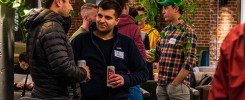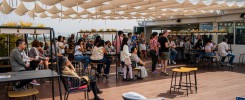The Changing World of Work

The Covid-19 crisis forced us all into the biggest ever work from home experiment. Not only has this been a test of our technology it has also tested trust and rapidly accelerated the ongoing trend towards more people centric, distributed workplaces. Businesses are complex with many moving parts that all must work in sync. Companies spend millions of dollars making their business more efficient, making them perform better only to realize that they are playing an elaborate game of whack-a-mole.
Simply making one part of your business more efficient helps, but the business is still only as strong as the weakest part. For many organizations, the workplace is one of the weakest parts. Real estate has a model built on rigidity and permanence, yet the world now demands real time flexibility and adaptability. No longer is this flexibility simply a demand from companies in response to uncertainty, it is now being demanded by teams, by people.

Despite many attempts the real estate industry has not been able to find a sustainable, profitable, financeable way to accommodate flexibility with the core purposes of the office: to create a real deep connection to culture, purpose, to deliver a high hospitality, amenity and service rich environments that makes peoples’ lives easier and to provide the environments that enable the spark of creativity that ignites into an explosion of innovation.
It must find the missing link between the rapidly changing needs of people and businesses and the timelines of the real estate world. Concurrently, it must shift from a top down imposition to a bottom up creation.
COVID – The catalyst of accelerated change
The cost of COVID in human life has been unbelievably tragic. The economic costs will be felt for years, the physiological costs likely much longer. How is this really going to impact the workplace, both in the short term and the long term? In such a rapidly changing environment we can only guess on the human impact. Previously 77% of companies in the US had 5% of their team working from home, a recent survey by Gartner expects that to double to 10%. The workplace was changing long before COVID-19 hit, the current crisis has massively accelerated the change. Specifically, it has accelerated the focus on the people side of the real estate equation. It has proved that people want and need multiple types of environments to be the best that they can.



Werqwise's new temperature gates are just one of their latest installations to ensuring a safe and healthy work environment.
According to recent research from Gartner, only 30% of employees worked from home some of the time pre-Covid, whereas indications are that 41% of those who are given the option to work remotely will do so for some of the time in the future. While 41% is still a low number and, of course these people continue to work in core office locations some of the time, it does represent a 37% increase.
From a company’s perspective this crisis has accelerated the demand for flexibility and agility as previous economic crises have. From the perspective of people, this crisis has had the previously unseen impact of also accelerating individual demand for flexibility. Companies are more willing to accommodate this given the positive, task-based productivity improvements of Work From Home and despite the negative impacts on creativity, culture, mental health, and relationships.
Is the physical work environment equation solvable?
Despite being the most difficult and cost-heavy aspect for most businesses, people and their performance is the greatest untapped return. Huge investments are being made to solve the people equation in business. Real estate and the evolving workplace also needs a new more democratized solution. What is needed is the right working environments so that people can perform, at their best.
This is not a new concept, the office has evolved from private offices, cubicles with tall walls and grim colors through the lowering of the walls. We focused on lighting, open spaces, different colors for different teams, helping people be more effective. The evolution spread further to open tech enabled spaces and on to super campuses with gourmet food and drinks.

These developments have opened the doors to a variety of amenities, from pets, bikes, sports and much more. Yet the humanization of the workplace is much more than foosball and Kombucha. It is about intense listening, learning, and changing behaviors. It is about understanding psychology, roles, tasks, interactions and the connectivity between people, processes, and technology. If you layer in the blurring of lifestyle and workstyle and the need for continual innovation and collaboration, the equation looks unsolvable.
Taking all these factors into account and redesigning spaces is only part of the solution. We need to work out how all factors fit together, smoothly in sync with each other. The next era of business will be about how we close the gaps between all of the parts of a business and the people that work within it.


